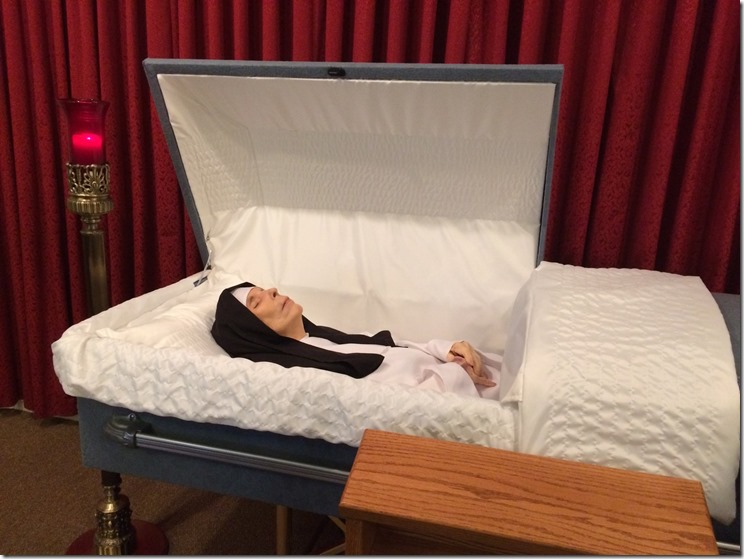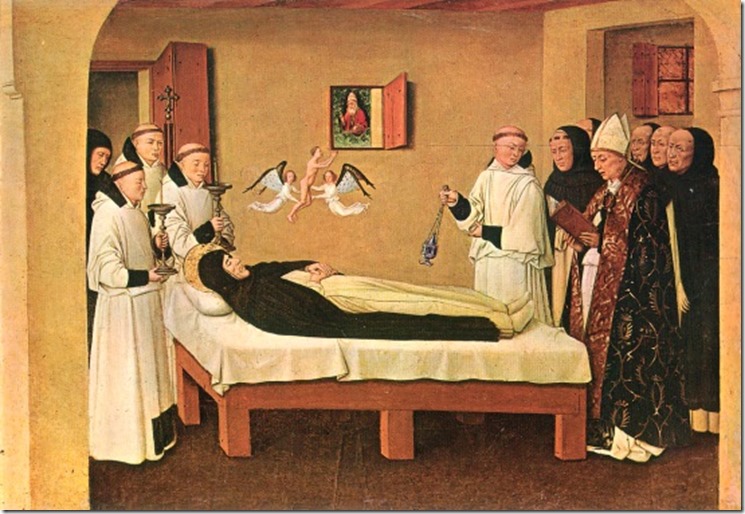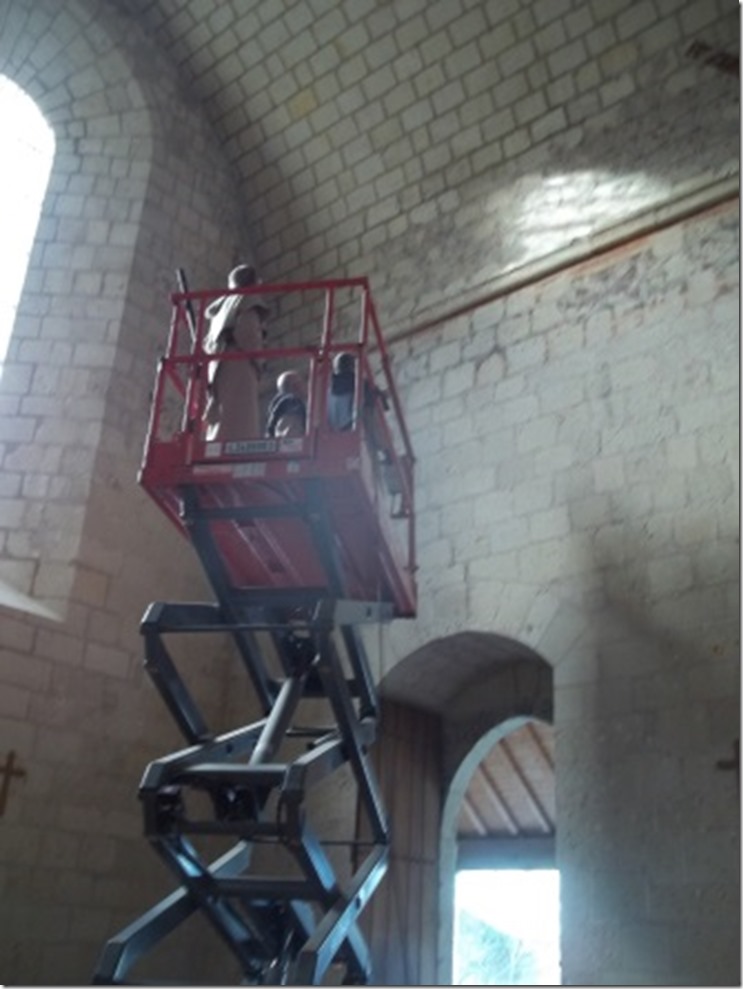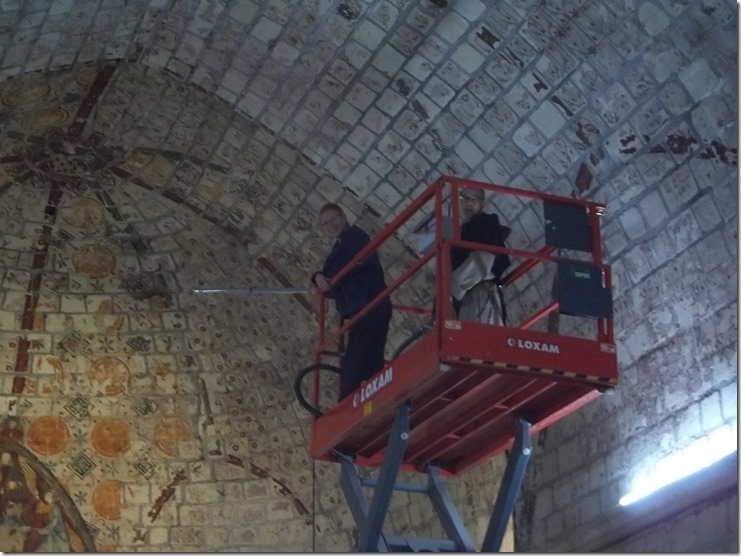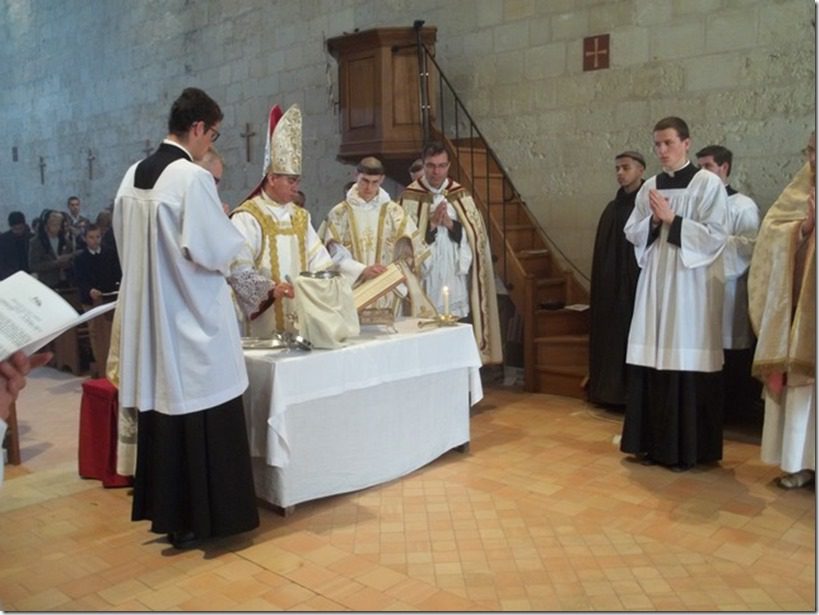Conciliar Bishops in Schools of Tradition
Excerpts from Le Sel de la Terre 109 (Summer 2019)
Two recent events seem to mark a new stage in the process of reconciliation between the Conciliar Church and the Society of Saint Pius X.
— The first event is an official visit by Monsignor Egan, Bishop of Portsmouth, to the SSPX School of Saint Michael in England.
Bishop Egan was invited by the principal to visit the school on March 8, 2019. During the visit, he led the prayer of the Rosary for the children in the chapel. The Oblate Sisters of the school refused to participate in this prayer.
After Bishop Egan’s visit, the principal told the children that Bishop Portsmouth was a man of good will, and that he was not bad.
It is possible that, as a private person, this bishop is “a good man,” but he is part of the system which is called the Conciliar Church.
For example, he paid a visit to the Southampton Mosque on June 5, 2017 to join the Friday prayers. Hère are some excerpts from his speech:
So on behalf of all Catholic Christians in this region, I offer you today our sincerest greetings and prayers for a Happy Ramadan. Ramadan Mubarak! This morning in Rome, our Pope, Pope Francis, has just sent a special message to all our Muslim friends across the world, to assure you of our prayers during this time of fasting, prayer and charity. […] Both Muslims and Catholics believe the Earth is holy; it belongs to God. It’s His work and so we must treat it with respect. So let us pray that the ecological crisis humanity is facing will call everyone in the world to a profound interior conversion, and to a renewed care for the Earth, our common home. […] Great Britain is a highly secular society. Yet you and I, Muslims and Christians, we are people of religion, faith and spirituality. We believe in God, and we believe that every human being is called to know Him, serve Him and love Him, to worship Him and to respect Him, and to find in Him ultimate happiness. It’s our task to witness to this in society, so that other people, those who say they have no religion, those who say they’re not sure, those who are lost or on the margins, can find their way home to Him. […] Please pray for me, and for the Catholic community here in Southampton and across our whole diocese 1.
It is clear that this bishop is spreading the modernism of Vatican II and that he is not unobjectionable.
Also, this visit provoked, among other things, the resignation of the superior of the Oblates, Sister Mary-Elizabeth.
— The second event is the arrival of Bishop Vitus Huonder, former bishop of the Diocese of Chur, to a school of the SSPX in Switzerland to retire there.
Vitus Huonder was born on April 21, 1942 in Trun, in the canton of Graubünden. He studied at the Abbey of Einsiedeln, at the Pontifical Athenaeum of Saint Anselm in Rome, and finally at the University of Freiburg again in Switzerland where he obtained his university degree and in 1973 his doctorate in theology.
He was ordained a priest on September 25, 1971 (thus in the new rite) by Bishop Johannes Vonderach and consecrated bishop of Chur (this diocese includes the cantons of Graubünden and Zurich) on September 8, 2007 by Bishop Amédée Grab. Hence arises the question of the validity of his ordination and consecration. We know that Archbishop Lefebvre did not hesitate to conditionally ordain those of the new rite.
As to the bishops consecrated in the rite of Paul VI, the only known example of a bishop who joined Tradition is Bishop Lazo 2. This return to Tradition took place after the death of Archbishop Lefebvre, but the SSPX has prudently kept away from ensuring him about episcopal functions.
Until the first of January of 2011, Monsignor Huonder was President of the European Community of Labor of the Christian Churches in Switzerland, where he gave the position to “anglican pastor” Adèle Kelham, until then Vice-President of the CTEC (Council of Christian Churches in Switzerland) 3.
Bishop Huonder was also a delegate of the Swiss Bishops’ Conference in the Jewish-Roman Catholic Dialogue Commission (JRGK for Jüdisch/Römisch-katholische Gesprächskommission der Schwei in German).
Under his chairmanship, this Commission designed and prepared the first Dies Judaïcus (Day of Judaism). It took place in Switzerland on March 20, 2011, and then was extended to other countries. We read in the message of Bishop Huonder:
On the second Sunday of Lent, March 20, 2011, the Swiss Episcopal Conference establishes the Dies Judaicus, the Day for the Jewish People. […]
This day has a double purpose. If the first objective of the Dies Judaicus is to return to the past, considering the people of the twelve tribes and the origin of the Christian faith, the effective reality of solidarity with the Jewish people reminds us of the permanent and ever present responsibility of the Church towards the Jewish people.
The terrible aggressions against this people during the Second World War led the Church to renew this responsibility and to make these declarations that we can read in the conciliar document Nostra Aetate. […]
In view of the reality that anti-Semitism has spread again in recent years, the Church once again feels the need to ask for solidarity in our country with the Jewish people. […]
I would like to highlight here the words of Saint Paul, who refers to our Jewish brothers and sisters: “because the gifts and the call of God are irrevocable.” (Romans 11,29).4 If the gifts and the call are irrevocable from God, that can only mean one thing: that the God and Father of all men pursues his plan of salvation for Israel. God is following His plan of salvation even today with the chosen people. He does not let his people fall. He also leads them in our days, because he seeks the salvation of all men: “[…] He wants all men to be saved and come to the knowledge of the truth” (1 Tim 2, 4).
From there, we want to pray that this irrevocable grace and call granted to Israel bear fruit even today, that they favor justice and mutual respect, and also contribute to unity and peace between all peoples 5.
In 2015, Bishop Huonder participated in discussions with the authorities of the Society of St. Pius X.
We publish here an interview of Bishop Huonder published in the Tagespost 6, and an excerpt from the letter of Monsignor Huonder to his diocesan alumni where he explains that “the intention of Pope Francis” in this process is “to integrate” [the Society of Saint Pius X].
Monsignor Huonder Interview of April 11, 2019
An interview with Bishop Huonder with Oliver Maksan was published in the Tagespost of April 11, 2019. We extract the passages which concern his coming to a school of the Society of Saint-Pius X.
The Tagespost:
Monsignor, you will spend your retirement in an institution of the Society of Saint Pius X. Did you have to obtain permission from the Holy Father to settle in a school of the Society?
Bishop Vitus Huonder:
No, because that is said in a letter to the Society from the former Prefect of the Congregation for the Doctrine of the Faith, Cardinal Gerhard Ludwig Müller. And the Prefect speaks with authority and with the approval of the Pope. But I have informed the Holy Father.
The Tagespost:
You are supposed to be the link between the Society and Rome. How did you get to this role?
Bishop Vitus Huonder:
For a long time I have been involved in the process of dialogue between Rome and the Society. Since the Headquarters of the SSPX are based in Menzingen, Switzerland, it was thought that a Swiss bishop should be involved. That’s why the Ecclesia Dei Commission, in charge of dialogue with the Society, asked me. This led to constant contact with the representatives of the Society here in Switzerland. I sent the reports to Rome. Now I will continue carrying out this mission. My main concern is the unity of the Church. The division in the Church must be overcome. We must not forget: The Society of Saint Pius X has many followers.
The Tagespost:
Your position is informal. It does not have concrete negotiating powers, but you try to be a bridge by being with them.
Bishop Vitus Huonder:
Yes, my role is mainly informal. But that also has its effects. For example, in the Year of Mercy, when the priests of the Society received permission from the Pope to give absolution. I was involved. I myself proposed to Pope Francis that he also had mercy on the Society and gave them powers. A year later I saw him again and he said he would accept my proposal. This encouraged me to continue on the path of unity with the Society.
The Tagespost:
Now this path has been followed for years without any agreement being reached. There seemed to be an approach under the direction of the former Superior General, Bishop Fellay. Under the new Superior Pagliarani, one has the impression that there is again an ice age, which is no longer about practical questions of integration in the Church, but about difficult doctrinal questions.
Bishop Vitus Huonder:
This may seem like that to the outside world. But there were also doctrinal concerns in the Society under the direction of Bishop Fellay. Maybe now they are getting a little more precise again. I do not know if a new era of ice is coming. But, above all, we have to work on this so that a good solution is reached.
The Tagespost:
How is that? What would the Society have to do now, what would Rome have to do to reach an agreement?
Bishop Vitus Huonder:
In the first place, it would be necessary to recognize the commitment of both parties, even if they have not yet reached a theological agreement. The Society should positively underline the seriousness of the Apostolic See. The Apostolic See, in turn, must appreciate the efforts of the Society and take its concerns more seriously.
In the Society one should not have the impression that they are welcomed in order to encircle them in some way. Then it would be easier to solve the theological problems that really exist.
The Tagespost:
Should the Society accept the Council in its entirety? Or can there also be forms of gradual recognition, as do Council documents which, by their weight, are not all on the same level?
Bishop Vitus Huonder:
Without a doubt, we should base ourselves on this principle. Not all the documents of the Council have the same value. Above all, the documents of the Second Vatican Council must be considered again, with more force, as a development of the previous period. On the part of the Congregation for the Doctrine of the Faith, it would be necessary to link more strongly with the pre-conciliar Magisterium in order to facilitate the recognition of the Council to the Society. It is about better demonstrating the continuity of doctrine.
Farewell letter from Bishop Vitus Huonder to his former diocesans
On the 20th of May, 2019, Bishop Vitus Huonder wrote to his former diocesans in order to explain the reasons for his exit.
[…] Ich selbst nehme nun, wie bereits bekannt, meinen Wohnsitz im Wohntrakt des Priesterhauses im Institut Sancta Maria in Wangs/SG. Dieses Institut gehört zur Priesterbruderschaft St. Pius X. Im Sinne von Papst Franziskus werde ich mich bemühen, dort zur Einheit der Kirche beizutragen, indem ich nicht ausgrenzen, sondern unterscheiden, begleiten und integrieren helfen möchte.
I myself, as is already known, have chosen to move to the building of the priests of the Sancta Maria Institute, in Wangs (St. Gallen), belonging to the Society of Saint Pius X. In the intention of Pope Francis, I will endeavor to contribute to the unity of the Church wishing to help, not to marginalize, but to discern, accompany and integrate 7. […]
Translation by J.F.
Addendum:
Sunday August 4, and Thursday August 15 (for the Feast of the Assumption of Our Lady) Bp Huonder celebrated a solemn High Mass (with Deacon and Subdeacon) and preached in Oberriet (German Switzerland), an important priory of the SSPX (350 faithful).
1 — See: http://www.portsmouthdiocese.org.uk/enews/mosque-visit.php
2 — See his beautiful profession of faith in Le Sel de la terre 26, p. 162. He said among other things: “I am not of the Rome of the Masons. Pope Leo XIII condemned Freemasonry in his encyclical Humanum Genus in 1884. Additionally, I am not of the Rome of the modernists. Pope Saint Pius X condemned modernism in Pascendi Dominici Gregis, in 1907. I do not serve Rome controlled by Freemasons who are the agents of Lucifer, the prince of demons.” Is Bishop Huonder ready to make such a declaration?
3 — https://www.cath.ch/newsf/l-une-des-rares-femmes-a-remplir-une-telle-fonction-au-plan-mondial-elle-remplace-mgr-vitus-huonder/
4 — See on this subject: “Against the diversion of Romans 11, 29,” in Le Sel de la terre 58, Fall 2006, p. 10-16.
5 — http://www.bischoefe.ch/dokumente/botschaften/message-pour-le-dies-judaicus-20-mars-2011.
6 — Die Tagespost is a newspaper appearing three times a week (Tuesday, Thursday, and Saturday}. Formerly known as Deutsche Tagespost, its subtitle is Catholic Journal on politics, society, and culture. It is published in Würzburg.
7 — It is difficult not to see in this sentence an allusion to the deplorable chapter VII of the exhortation Amoris lætitia (March 19, 2016), which exhorts towards “a pastoral discernment filled with merciful love, which is ever ready to understand, forgive, accompany, hope, and above all to integrate.”


